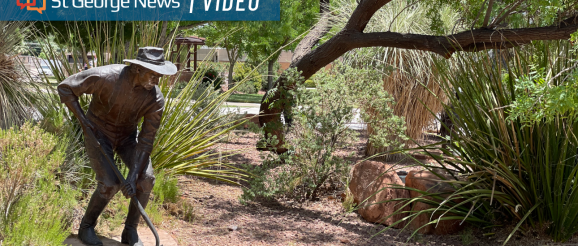Utah Tech progresses into planning stage of 183-acre Innovation District

ST. GEORGE — Utah Tech University has officially transitioned into the planning stage of its “Innovation District” – a potentially 183-acre campus near Desert Color Center, west of St. George Regional Airport.
According to Utah Tech’s preliminary prospectus, “The District will provide high-impact and transformational opportunities for students to engage in active and applied learning with industry partners in laboratories, research and development facilities, business incubators and accelerators that advance career readiness of graduates.”
“Phase 1 of the (Utah Tech) Innovation District Campus would ideally open by 2026,” the presentation said, “and eventually range in size from a few dozen acres to possibly the entire 183 acres of the property.”
“The District would be governed through the (UTU) Innovation Foundation and/or affiliated entity(ies) with a 2030 goal of producing $100-$200 million in annual economic activity and supporting applied and authentic education experiences for 2,000+ undergraduate and graduate students.”
Michael Lacourse, Utah Tech’s provost and vice president for academic affairs, spoke to St. George News about the university’s official plans for the project.
Lacourse said Utah Tech wants to create an “innovation ecosystem,” where “different pieces of people with money, expertise and business formation” in the community can collaborate with Utah Tech students in order to mutually benefit all involved.
Utah Tech already has an Atwood Innovation Plaza on campus that shares a similar vision with this upcoming Innovation District, but Lacourse explained that despite being open for only five years, the Innovation Plaza is already at max-capacity.
“We just don’t have enough space,” Lacourse said. “We’ve had about 200 patent applications come out of the Innovation Plaza in the past five years. We have about 50 businesses that have come out of that center. Right now, the building is filled with small companies incubating. We’ve outgrown the space.”
Lacourse wants to expand the Innovation Plaza’s vision into the new District, further developing the amount of interaction between students and community startup businesses, while still keeping the Innovation Plaza for smaller/upcoming businesses.
Lacourse explained this is called “bumpability,” what he calls “incidental interactions with opportunities where ideas are constantly flowing … where the resources are there to help you take an idea and turn it into intellectual property.”
“The idea is that because you’ve got all these people with all this expertise, all this creativity, all in a small space, you force them to bump into each other.”
On top of greatly benefiting Utah Tech students in their career growth, Lacourse said, the District will also help keep tuition low by providing additional funding to the university.
Cheryle Caplinger, Utah Tech’s executive director of strategic partnerships and academic affairs, clarified how this Innovation District differs from other universities’ Innovation Districts, such as MIT, San Diego State University and Georgia Tech.
“A lot of innovation areas you run into are retrofitted spaces, like the one in California being an old football stadium,” Caplinger said. “Ours is interesting because we’re creating it from scratch.”
“Sometimes you see (Innovation Districts) doing lots of research with a lot of third-party companies, and you may or may not see people working together,” she said. “That’s going to be the difference here — we are going to see this as a very active space that people are working collaboratively on a regular basis.”
As a member of the Association of University Research Parks, Caplinger is Utah Tech’s primary liaison. She interacts with other universities and Innovation District managers regularly and collects ideas about lessons learned from other universities.
Caplinger said the upcoming Innovation District will help solve concerns within Southern Utah, such as finding water solutions through water desalination and creating research to lower the costs of local power usage.
The concept of Innovation Districts first took shape in the 2014 research project titled “The Rise of Innovation Districts: A New Geography of Innovation in America,” by Bruce Katz and Julie Wagner of the Brookings Institute.
Copyright St. George News, SaintGeorgeUtah.com LLC, 2022, all rights reserved.
